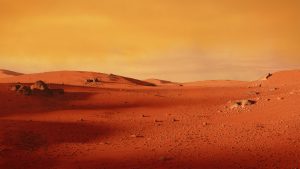
SUB.B | Mars
In the last module we started a tour of our local neighbourhood – our solar system. We took a 146 million-kilometre trip from our home here on Earth to the sun, the star at the center of our solar system, with brief stop-overs at Venus and Mercury, the two closest planets to the sun. Now, we’re going to shoot right past the sun and head off to our next closest, and most studied neighbour, the red planet known as Mars.
Travelling at the same speed at which we made the last trip, around 28 thousand kilometres an hour, it will take 814 days to traverse the 228 million kilometres between the Sun and Mars – and to save you a bit more math, yes, that is two years and three months of flight time at that speed. If you were travelling that distance at the speed of commercial jet liner, around 850 kilometres an  hour, it would take 11,167 days – that’s around thirty years.
hour, it would take 11,167 days – that’s around thirty years.
Getting the idea of how big the solar system is?
Alright, on our way to Mars – at a more reasonable speed.
As we approach Mars, you’re going to notice some strange objects floating around our red neighbour. The first will be a funny shaped rock about six kilometres across cruising around Mars at a distance of 23,460 kilometres. This is the “moon” called Deimos, named for the god of terror in Greek mythology, although really, it’s not that scary. Deimos is just a funny shaped rocky body that might have been an asteroid captured by the Martian gravity.
And as we get closer to Mars, we find Deimos’ brother, Phobos, named for the Greek god of horror – but again, not really that scary. Phobos is larger and more massive than Deimos at eleven kilometres in radius, and orbits Mars at around 9500 kilometres above the surface. It’s also very small compared to our moon, and is probably an asteroid that Mars grabbed as it was passing nearby. Eventually, Phobos is expected to either crash into Mars’ surface or rip apart, because the gravitational force of the planet will overpower it. That won’t happen for another 30 million to 50 million years, though.
 Other objects you’ll find orbiting Mars will be some shiny gifts sent by Earthlings to study the planet, namely the MRO – Mars Reconnaissance Orbiter, the Mars Odyssey, MAVEN, as well as a few others. For a review of Mars Rovers from our ROVs and AUVs Module, click on the images at the bottom of the page.
Other objects you’ll find orbiting Mars will be some shiny gifts sent by Earthlings to study the planet, namely the MRO – Mars Reconnaissance Orbiter, the Mars Odyssey, MAVEN, as well as a few others. For a review of Mars Rovers from our ROVs and AUVs Module, click on the images at the bottom of the page.
Mars itself is named after the Roman god of war, probably because of the associations of the color red with war and bloodshed. Similarly, ancient Babylonians called this planet Nergal, after their god of fire, war, and destruction. Of course, Mars isn’t red because of blood, but because of the iron oxide (rust) particles in its soil.
Mars is the second smallest planet, a little more than half the size of Earth, and so it has less gravity. You know all of those films of astronauts on Mars just walking around like the would on Earth? Well, it won’t look quite like that, but it won’t be nearly as extreme as the Apollo astronauts experienced with our moon’s one-sixth gravity. Still, it will be a lot easier to carry heavy loads on Mars than it is back on Earth. Also, Mars’ atmosphere is not only thin, it’s made up mostly of carbon dioxide, so no breathing for Earthlings here, at least not without help!
A day on Mars lasts just a bit longer than one here on Earth – specifically, about 25 hours. A year, however, lasts almost 23 months.
The USSR’s Marsnik 1, launched in 1960, was the first spacecraft to target Mars. In total, there have been 47 Mars missions, though only 19 of them have been successful. NASA’s next Mars rover, Perseverance, is scheduled to launch in the summer of 2020. Nicknamed Percy, this rover will look for signs of life on Mars, study the surface of the planet, and map potential hazards to future manned missions. Alex Mather, who proposed the winning name for the rover, is a seventh-grader, and won a free trip to Cape Canaveral, Florida, to watch the launch.
When it comes to colonization, Mars is our most likely target. Its proximity and relative similarity to Earth make it a natural option to set up a permanent base. Currently, SpaceX is developing a series of Mars-bound cargo flights scheduled to take off as early as 2022, followed by the first crewed flight to Mars in 2024.
Curriculum Reference Links
- Earth and Space / Building Blocks/ 1: Students should be able to describe the relationships between various celestial objects including moons, asteroids, comets, planets, stars, solar systems, galaxies and space.
- Earth and Space / Building Blocks/ 3: Students should be able to interpret data to compare the Earth with other planets and moons in the solar system, with respect to properties including mass, gravity, size, and composition.




